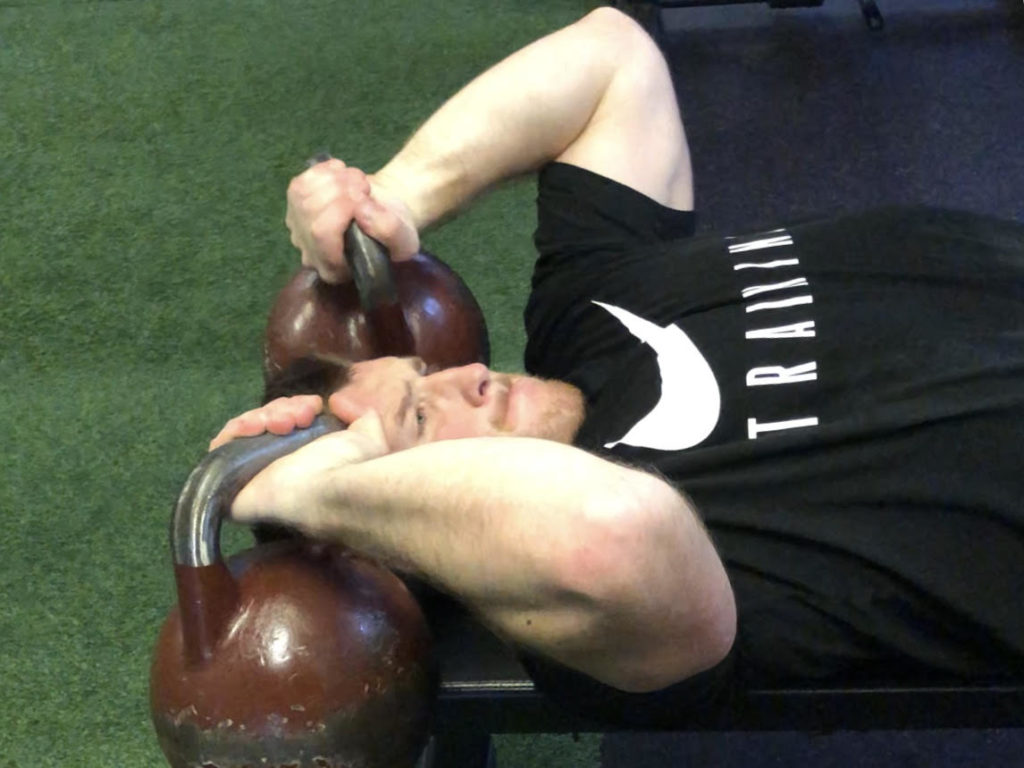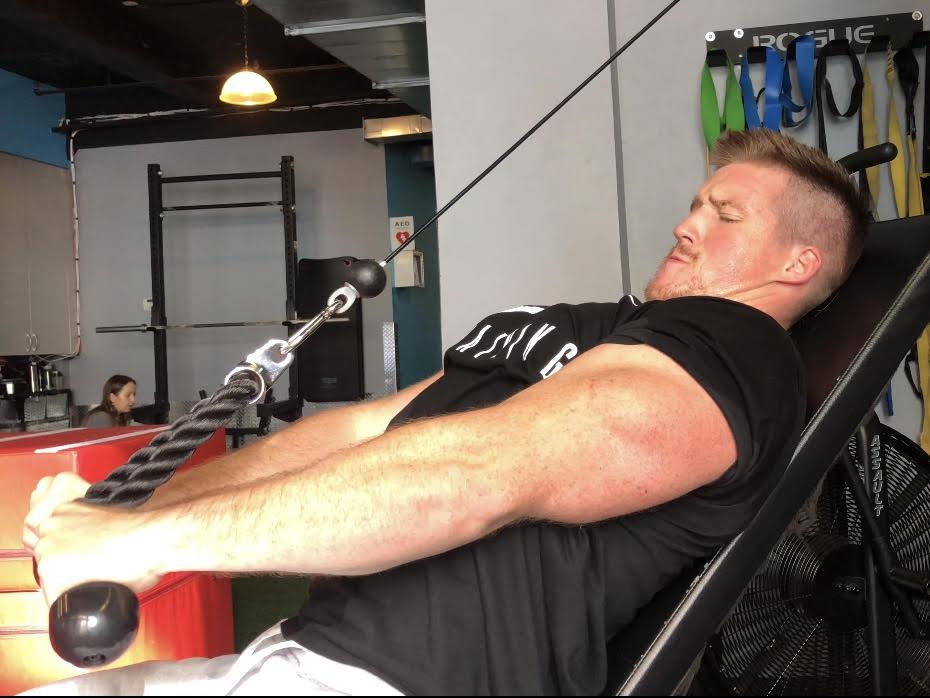Big triceps are not just a symbol of hard work and consistent effort in the gym, they are highly functional and necessary for serious strength and power athletes. Without them, bench pressing will stall, overhead movements will have limitations, and elbow pain may plaque some smaller triceps trainees.
Building stronger triceps is often done via strength lifts, however some athletes may require additional training dedicated to triceps development. It is for this reason, that we have put together the below 14 exercise: to arm coach and athletes with knowledge and motivation on how to attack muscle weakness and boost triceps strength and performance.
In this article, we will discuss:
- The Importance of Triceps Training
- How to Integrate Triceps Training Into Your Program
- 14 Triceps Exercises to Improve Your Bench Press (8) and Overhead Strength (6)
Why Do Strong Triceps Matter?
Strong triceps can help you lock out heavier loads in the bench press, break through sticking points in the overhead press, and finally fill out the size XL shirt you have been dying to wear. The triceps make up nearly ⅔ of the arm itself, which should help you realize that they are not only for show but are highly functional for pressing movements. If you are a serious strength athlete (weightlifters too), having strong triceps is a necessity for performance.
In addition, stronger triceps can help to stabilize the elbows under load, which is beneficial for joint health during pressing programs and overhead ballistic movements like jerks and snatches.
How to Integrate Triceps Exercises into Training Programs?
Triceps can be trained in two primary ways, both of which offer coaches and athletes unique benefits. The below recommendations can be used to help integrate the 14 triceps exercise that are in the later sections into a strength and hypertrophy program.
Strength Variations
About half of the triceps exercises below can be done in most strength blocks, with heavier loads to challenge triceps and lockout strength. These can be done in place of heavier bench pressing and/overhead pressing or as variations mixed in from time to time (they can also be done as accessory lifts, see below). If you choose to have these done for strength, be sure to program them in a similar manner that you would with any strength lift (bench press, squat, etc). Typically, this means using moderate to heavy load for 3-6 sets of 2-5 repetitions (however total sets and reps can vary based on goal and training level).
Accessory Work
If looking to add triceps exercise into accessory blocks, coaches and athletes can do so on days where the successive workouts are not highly depended on upper body pressing strength. If done a day before benching or overhead pressing, it is easy to think that the triceps themselves will be fatigued and limit your ability to bench/overhead press, which seems highly counter-productive.
Instead, choose to place triceps work at the end of benching/pressing days, or on days where you will not need them for later workouts. As far as sets and repetitions go, the triceps won’t need too much volume since they are often trained already in a balanced pressing program, however start by using 2-3 exercises a week with 3-4 sets of 8-12 (maybe more depending on the goal) repetitions with moderate to heavy loads (assuming the goal is size and strength).

8 Triceps Exercises to Improve Bench Press
Below are eight (8) triceps exercises that can be integrated into current bench pressing strength cycles or accessory blocks to improve lockout performance and strength.
Floor Press
The floor press is a bench press variation that limits the range of motion of the press (due to the lifter being on the floor). In doing so, the elbows flex to about 90 degrees, making the triceps the primary mover in the press (as the chest muscles are more active in deeper shoulder ranges of motion). This can be done with a barbell, dumbbells, or specialty bar for both strength and hypertrophy work.
Pin Press (Bench)
A pin press is done by setting the safety pins or racks at a height that is off the chest, limiting the range of motion in the bench press. Like the floor press, the pin press forces a lifter to isolate a sticking point and build concentric strength to get through that point. This can be done for strength work to isolate a lifters sticking point or for more volume based work to increase triceps hypertrophy.
Close Grip Press
The close grip bench press is done by narrowing the grip on the barbell in the bench press, and can be used for flat, decline, and incline bench pressing variations. By moving the hands narrower, you force the elbows to go into a deeper flexion angle at the bottom of the press, making the triceps have to exert higher amounts of force to extend and lock out the lift. This exercise can be done for volume or for strength, with dumbbells, barbells, or Swiss/multi-grip bars.
Dips
Dips are good strength and hypertrophy exercise for most strength, power, and fitness athletes. Unlike the other movements, the dip is an exercise that vary the pressing stimulus (not a direct variation of a bench press) which can add strength and mass and increase pressing capacity outside of the normal bench press range of motion. By diversifying the pressing movements, a lifter can stimulate new strength pathways and muscle tissue. Lastly, the dip can be done in limited ranges to increase triceps development while also still increase chest hypertrophy and strength.
Board Press
The board press is another partial range of motion bench press variation that can be used to specifically target the triceps and lockout strength in the bench press. Similar to the pin press and the floor press, the lifter eccentrically loads the chest and triceps until the barbell hits a board (of varying thicknesses) on their chest, which in turn they then press the weight upwards with the triceps. This exercise is often done in street blocks, however can also be used in hypertrophy phases as well.
Skull Crushers
Skull crushers are a single-joint exercise that can be done with moderate (and sometimes moderate to heavy) loads to increase triceps strength and hypertrophy. This exercise is often done in accessory blocks after main strength work, with either a barbell, dumbbell, specialty bars, or kettlebells.
Tate Press
The Tate Press, named after powerlifter Dave Tate, is a lying triceps extension/pressing variation that is often done in accessory blocks for moderate to higher volume. Similar to the dumbbell french press, the Tate press can be done to isolate the triceps after more dedicated strength work for pressing to increase muscle damage and promote size and general elbow extension strength.
Triceps Pushdowns (Cable or Band)
Banded triceps pushdowns can be done for higher volumes to increase muscle endurance and hypertrophy after main strength and accessory work. This exercise is single-joint in nature, meaning it targets only the triceps. Athletes can use cable systems or resistance bands, with bands being highly accessible for most training environments with an added bonus of accommodating resistance training.

6 Triceps Exercises to Improve Overhead Press
Below are six (6) triceps exercises that can be integrated into current overhead pressing strength cycles or accessory blocks to improve overhead performance and strength.
Pin Press (Overhead)
A pin press is done by setting the safety pins or racks at a height that is off the shoulders (with the lifter in the seated, standing, or unsupported upright position). Like the partial overhead press, the pin press forces a lifter to isolate a sticking point and build concentric strength to get through that point. This can be done for strength work to isolate a lifters sticking point or for more volume based work to increase triceps and shoulders hypertrophy.
Push Press
The push press, while still a primarily shoulder pressing movement, does have the ability to promote triceps strength and improve overhead lockout performance for other movements like strict presses and jerks. Due to the ability to utilize lower body muscle, the lifter can often accelerate heavier loads higher into the sticking point ranges, in which the shoulders and triceps must work maximally to lockout loads that otherwise would not be able to be placed overhead (if they were done from a strict press). Despite the fact that this exercise is a shoulder movement, one cannot ignore the fact the inability to lock out elbows in the press or maintain overhead stability in a jerk, snatch, etc can be positively influenced by the inclusion on the push press and the triceps development that some with it (and its variations).
Close Grip Overhead Press
The close grip overhead press is done by narrowing the grip on the barbell in the overhead press, and can be used for seated, standing, and unsupported upright pressing variations. By moving the hands narrower, you force the elbows to go into a deeper flexion angle at the bottom of the press, making the triceps have to exert higher amounts of force to extend and lock out the lift. This exercise can also be done with specialty bars that change the angle of the hands (multi-angle bar) and/or dumbbells in the neutral position.
Military Press with Chains
Adding chains (and bands) are a good way to incorporate accommodating resistance training with standard strength and hypertrophy exercises, which can be a good way to overload the specific ranges of motion in which the triceps are used the most in the press. By setting the chains to add resistance after the initial 2-3 inches off the body, the lifter must develop a stronger lockout via elbow extension (triceps), maximizing both overhead pressing strength and muscle development.
Seated Partial Strict Press
Partial repetition strict presses can be done to increase the strength and muscle development at various phases of the strict press. If the goal is greater triceps engagement, lifters could perform half presses to overload not only the shoulders but the triceps as well; which are responsible for elbow extension/lockout. This can be done using barbells, machines, and dumbbells in both strength and accessory blocks.
Handstand Push Up (Strict)
Similar to the partial strict press, the handstand push up (when done so that the lifter focuses on the top half of the press) can be an effective bodyweight exercise for targeting the triceps and shoulders, both responsible for overhead stability and elbow extension/lockout strength. Typically, these can be done so that when in the bottom position the lifters elbows are bent at about 90 degrees, or slightly less, with the elbows turn inwards towards the body (rather than flared out).
Featured Image: Mike Dewar